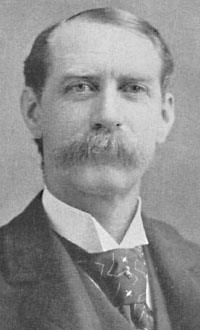Palmer Cox facts for kids
Quick facts for kids
Palmer Cox
|
|
|---|---|
 |
|
| Born | April 28, 1840 Granby, Quebec, Canada |
| Died | July 24, 1924 (aged 84) Granby, Quebec, Canada |
| Occupation | Illustrator, author, poet |
| Notable works | The Brownies |
Palmer Cox (born April 28, 1840 – died July 24, 1924) was a Canadian artist and writer. He is most famous for his series of funny books and comic strips called The Brownies. These stories were about small, mischievous, but kind-hearted fairy-like sprites. The cartoons were published in several books, like The Brownies, Their Book (1887). The Brownies became so popular that one of the first well-known handheld cameras, the Eastman Kodak Brownie camera, was named after them!
Contents
A Creative Life
Palmer Cox was born in Granby, Quebec, Canada. His parents were Michael and Sarah Cox. When he was younger, he worked as a carpenter and built train cars.
In 1863, he moved to San Francisco, California, by traveling through Panama. He lived there for about 12 years. During this time, he started to formally study drawing. He also began to share his illustrated stories with magazines like Golden Era and Alta California.
After 1875, Cox moved to New York. He continued to draw and write.
The Brownies Begin
The very first Brownie characters appeared in print in 1879. But it wasn't until February 1881, in Wide Awake magazine, that the creatures looked like their final, famous form. By 1883, Brownie stories were in St. Nicholas Magazine. As they became more popular, they even appeared in magazines like the Ladies' Home Journal.
What Are Brownies?
Cox's Brownies were little men who went on many fun and mischievous adventures together. Each Brownie had a special look. For example, Cholly Boutonnière wore a top hat and a monocle (a single eyeglass). Other Brownies wore clothes from different cultures, like Turkish, Irish, German, Swedish, Russian, and Chinese outfits. There was even an Eskimo Brownie, an American Indian Brownie, and an Uncle Sam Brownie!
People loved his books because the characters showed human nature in a good way. They showed goodness, strength, and even silly mistakes, but never anything mean or bad.
Brownies in Folklore vs. Cox's Brownies
Palmer Cox kept some ideas from the old stories about brownies in folklore. But he also made some important changes. In Scottish folklore, a brownie is usually a lonely creature who stays in one house. They do chores or farm work.
However, Cox's Brownies were different. They were very social and always stuck together. They would travel from place to place for their fun and to do kind deeds.
The legendary Scottish brownie, as Cox described, was "good natured and harmless." They never hurt anyone or caused damage. People thought it was very lucky to have a Brownie around the house. Most people couldn't see the folklore Brownie, only those with special sight. Cox believed that brownies got their name from their brown hair and faces that looked weathered from being outside.
Palmer Cox passed away on July 24, 1924, in his amazing 17-room home called Brownie Castle in Granby, Quebec. His gravestone has a Brownie figure on it. The inscription says: In creating the Brownies he bestowed a priceless heritage on childhood.
The Brownie Books and Other Works
Palmer Cox wrote and illustrated many books, especially about his famous Brownies. Here are some of his works:
- Squibs of California (1874) (later called Comic Yarns)
- Hans Von Petter's Trip to Gotham (1878)
- How Columbus Found America (1878)
- That Stanley (1878)
- Queer People, such as Goblins, Giants, Merry Men and Monarchs (1888)
- Queer People with Paws and Claws (1888)
- Queer People with Wings and Stings (1888)
- Frontier Humor (1895)
- The Brownies in the Philippines
- The Monk's Victory and other Stories by Palmer Cox (1903)
- The Brownie Clown in Brownie Town (comics 1907)
- The Brownie Calendar
- Palmer Cox's Brownies (a play)
- The Brownies in Fairyland (lyrics 1925)
Inspired by The Brownies
Palmer Cox's Brownies were very popular and inspired other artists and writers. This is called an "homage" when someone creates something new that shows respect or is influenced by an earlier work.
- A composer from Detroit named Effie F. Kamman wrote a popular song called "The Dance of the Brownies" in 1893. She was inspired by Cox's characters.
- Richard F. Outcault, another famous cartoonist, mentioned Cox and The Brownies in his comic strip Hogan's Alley on February 9, 1895. He even made a funny copy of them.
- In the children's book Rufus M by Eleanor Estes, which takes place during World War I, two siblings have a game. They look at Palmer Cox's Brownie books and race to see who can spot the Brownie with the top hat first in each new picture.
- The idea for the character of Dunno (Neznayka) in Russian children's books comes from Palmer Cox's Brownie stories. Dunno was created by the Soviet children's writer Nikolay Nosov.
Images for kids



